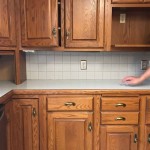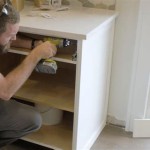How to Paint MDF Kitchen Doors
Medium-density fiberboard (MDF) is a common material for kitchen doors due to its smooth surface, affordability, and stability. However, MDF requires proper preparation and painting techniques to achieve a durable and aesthetically pleasing finish. This article provides a comprehensive guide on how to paint MDF kitchen doors, outlining the necessary steps, materials, and best practices.
The success of any paint job on MDF hinges on thorough preparation. MDF is highly absorbent and can swell if not properly sealed. Therefore, the initial steps are critical to prevent issues like warping, bubbling, and uneven paint absorption. Neglecting these preparatory stages often results in a finish that is prone to chipping, peeling, and discoloration.
Before commencing the painting process, it is essential to gather all the required materials. Having everything on hand will streamline the operation and prevent interruptions. The following is a list of necessary supplies:
- MDF kitchen doors
- Screwdriver or drill (for removing hardware)
- Cleaning supplies (degreaser, cloths)
- Sandpaper (various grits: 120, 220, 320)
- Sanding block or orbital sander
- Tack cloth
- Primer (specifically designed for MDF)
- Paint (suitable for kitchen use, e.g., acrylic latex, enamel)
- Paintbrushes (high-quality synthetic)
- Paint rollers (foam rollers for smooth finish)
- Paint tray
- Painter's tape
- Drop cloths or protective sheeting
- Respirator or dust mask
- Safety glasses
Step 1: Preparation and Cleaning
The first step in painting MDF kitchen doors is meticulous preparation. Begin by removing the doors from their hinges using a screwdriver or drill. Label each door and corresponding hinge to simplify the reinstallation process later. Remove all hardware, such as knobs, handles, and hinges, and store them in a safe place.
Clean the MDF doors thoroughly with a degreaser or mild detergent to remove any grease, dirt, or grime. Use a clean cloth to wipe the surfaces, ensuring all residue is removed. Allow the doors to dry completely before proceeding. Any remaining contaminants can interfere with the primer's adhesion, leading to an unsatisfactory finish.
Once the doors are dry, inspect them for any imperfections, such as dents, scratches, or chips. Fill any minor imperfections with wood filler specifically designed for MDF. Allow the filler to dry completely according to the manufacturer's instructions, then sand it smooth with 120-grit sandpaper. Ensure the repaired area is flush with the surrounding surface.
Sanding the MDF doors is crucial for creating a surface that the primer can properly adhere to. Using 120-grit sandpaper, lightly scuff the entire surface of each door. This process helps to create a profile for the primer to grab onto. Pay close attention to edges and corners, as these areas are prone to chipping. After the initial sanding, use 220-grit sandpaper to smooth the surface further. Remove all sanding dust with a tack cloth before proceeding to the next step.
Step 2: Priming the MDF
Priming is arguably the most important step when painting MDF. MDF is extremely porous and will absorb paint unevenly if not properly sealed. Using a high-quality primer specifically designed for MDF will create a barrier, preventing the paint from sinking into the material and ensuring a uniform finish.
Apply a thin, even coat of primer using a brush, roller, or spray gun. A brush is suitable for edges and corners, while a foam roller provides a smooth finish on larger surfaces. If using a spray gun, follow the manufacturer's instructions for proper application. Ensure the primer covers the entire surface of the MDF door, including the edges and any routed details.
Allow the primer to dry completely according to the manufacturer's instructions. This drying time is critical for the primer to properly seal the MDF. Once dry, lightly sand the primed surface with 320-grit sandpaper to remove any imperfections or raised grain. Remove all sanding dust with a tack cloth before applying the second coat of primer.
Apply a second thin coat of primer, ensuring complete coverage. This second coat will further enhance the sealing properties and provide a more uniform surface for the paint to adhere to. Again, allow the primer to dry completely according to the manufacturer's instructions. Once dry, inspect the surface for any remaining imperfections and sand lightly if necessary. Remove all sanding dust with a tack cloth.
Step 3: Painting the MDF Doors
After the MDF doors are properly primed, the painting process can begin. Choose a high-quality paint that is suitable for kitchen use, such as acrylic latex or enamel. These paints are durable, washable, and resistant to moisture and grease, making them ideal for kitchen environments. Select a paint color and finish that complements the overall design of your kitchen.
Before painting, protect the surrounding work area with drop cloths or protective sheeting. Apply painter's tape to any areas that you do not want to be painted, such as the edges of glass panels. Ensure the tape is firmly adhered to the surface to prevent paint from bleeding underneath.
Stir the paint thoroughly before use to ensure a consistent color and viscosity. Pour a small amount of paint into a paint tray. Using a high-quality synthetic brush, apply paint to the edges and corners of the MDF door. Then, using a foam roller, apply paint to the larger surfaces in thin, even strokes. Avoid applying too much paint at once, as this can lead to drips and runs.
Work in small sections, overlapping each stroke slightly to ensure complete coverage. Maintain a wet edge to prevent lap marks. If using a brush, apply the paint in the direction of the wood grain (if any) or in the direction of the routed details. If using a roller, apply the paint in a consistent pattern.
Allow the first coat of paint to dry completely according to the manufacturer's instructions. Once dry, lightly sand the surface with 320-grit sandpaper to remove any imperfections or raised grain. Remove all sanding dust with a tack cloth before applying the second coat of paint.
Apply a second thin coat of paint, ensuring complete coverage. This second coat will enhance the color depth and durability of the finish. Again, allow the paint to dry completely according to the manufacturer's instructions. Inspect the surface for any remaining imperfections and touch up as needed.
For added durability and protection, consider applying a clear coat of polyurethane or varnish. This clear coat will provide an extra layer of resistance against scratches, stains, and moisture. Apply the clear coat in thin, even coats, following the manufacturer's instructions for drying and application.
Additional Considerations
Proper ventilation is paramount when painting, especially when using oil-based paints or varnishes. Ensure the work area is well-ventilated by opening windows or using a fan. Wear a respirator or dust mask to protect yourself from inhaling paint fumes or dust particles. Safety glasses are also recommended to protect your eyes from splashes or debris.
When choosing a primer, opt for a product specifically formulated for MDF. These primers typically contain binders that effectively seal the porous surface and prevent excessive paint absorption. Tinting the primer to a similar color as the paint can also improve coverage and reduce the number of paint coats required.
Clean paintbrushes and rollers immediately after use to prevent the paint from drying and hardening. Use the appropriate solvent for the type of paint used (e.g., water for latex paint, mineral spirits for oil-based paint). Store paintbrushes and rollers properly to maintain their condition and prolong their lifespan.
Allow the painted MDF doors to cure completely before reinstalling them. Curing allows the paint to harden and reach its maximum durability. The curing time can vary depending on the type of paint used, but it typically takes several days to a week. Avoid subjecting the doors to excessive moisture or abrasion during the curing process.
When reinstalling the hardware, use new screws or bolts to ensure a secure fit. Avoid over-tightening the screws, as this can damage the MDF. If necessary, pre-drill pilot holes to prevent splitting or cracking the MDF.
Regular cleaning and maintenance will help to keep the painted MDF kitchen doors looking their best. Wipe the doors regularly with a damp cloth to remove dirt, grease, and fingerprints. Avoid using harsh chemicals or abrasive cleaners, as these can damage the paint finish. Touch up any chips or scratches promptly to prevent further damage.
By following these detailed instructions and paying close attention to each step, it's possible to achieve a professional-quality finish on MDF kitchen doors, enhancing the aesthetic appeal and longevity of the kitchen cabinetry.

Painting Mdf Cabinet Doors

Painting Mdf Kitchen Cabinets Theril Cabinet Redo Poofy Cheeks

Can You Paint Mdf Cabinets Pa Kitchen

Painting Mdf Kitchen Cabinets Theril Cabinet Redo Poofy Cheeks

How To Paint Laminate Mdf Kitchen Cupboards Work Space Makeover

How To Paint Theril Cabinets Life On Virginia Street

How To Paint Mdf Kitchen Doors At Home New Replacement

How To Re Paint Your Yucky White Cabinets

Painting Laminate Kitchen Cabinets Cuckoo4design

How To Paint Mdf Kitchen Doors At Home New Replacement
Related Posts








